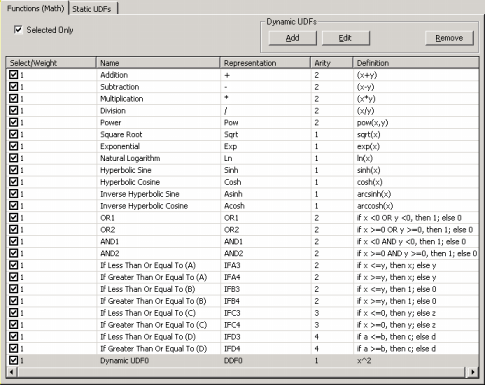| In the Functions Panel you choose the mathematical and comparison functions you think appropriate to model your data. Here you also choose the probability
(or the weight) each function has of being integrated in the chromosomes of the evolving models.

The functions you choose will consist of the function set. And besides the function set, the learning algorithms of APS also
use a terminal set. But unlike the functions in your function set which can be weighted as many times as you see fit, the terminal set is created automatically by APS and consists of the independent variables in your data and, therefore, you cannot weight each terminal differently. But, during adaptation, the chromosomes of the evolving models are created and modified using the elements of both the function and terminal
set, reflecting their relative representation. Thus, and no matter the kind of problem category (function finding, classification, or time series prediction), you must in all cases choose a well balanced function set, that is, the total number of functions in your function set must be at least equal to the number of variables in your data otherwise you are increasing the odds of creating excessively simple models which might make it harder for the algorithm to come up with more complex models.
APS 3.0 offers a total of 70 built-in functions to choose from, including the mathematical, trigonometric and comparison functions most commonly used by sophisticated programming and modeling software.
The functions you select in the Functions Panel
are the functions the learning algorithm will explore in order to create a good model for your data. The
learning algorithms of APS
cope very well with virtually any combination of mathematical functions. But sometimes for the sake of simplicity and intelligibility of your models it pays to be parsimonious and we recommend you give a try to one of the simplest function sets, the one composed of only the basic arithmetic operators. But, of course, the modeling of complex realities sometimes requires more complex functions and APS 3.0 provides a wide range of such functions. Furthermore, you can also
design other functions and add them to the function kit of APS and explore new solution spaces with them.
|